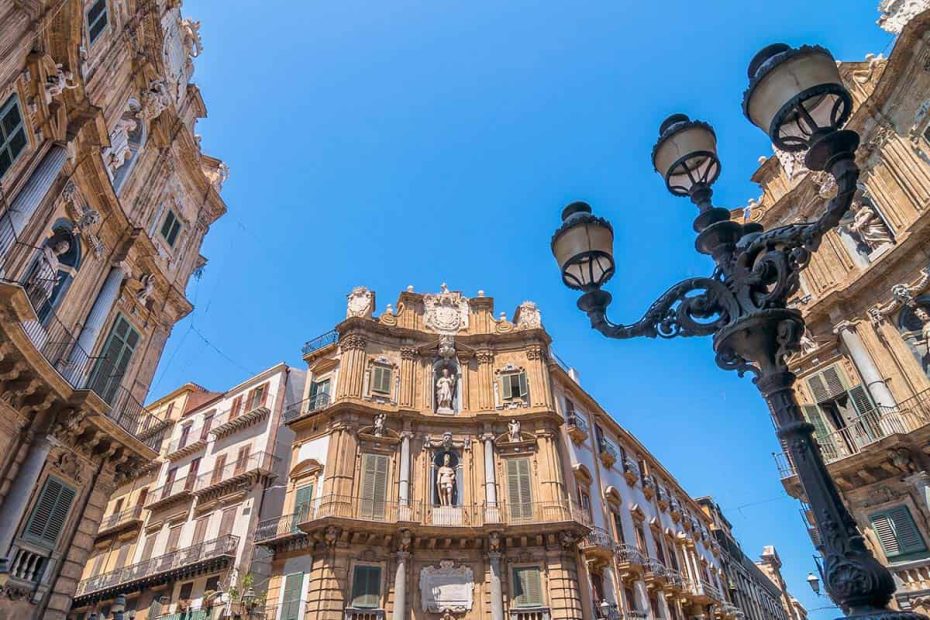“I Quattro Canti” (The Four Corners) is one of Palermo’s most spectacular and popular spots. The four buildings that outline the square were built between 1608 and 1620, while the sculptures and decorative elements were completed in 1663. Piazza Vigliena, one of the many names by which the Quattro Canti are also called, is the ideal starting point for a tour of Palermo city.
History of the Quattro Canti in Palermo
The origins of the Quattro Canti date back to 1600, when the Senate of Palermo decided to create a new street, Via Maqueda, to intersect with what is now Via Vittorio Emanuele and divide Palermo “into four noble parts”. Piazza Vigliena was thus formed at the intersection of these two streets. In 1608, they decided to architecturally unify the four buildings that bordered it. The Senate commissioned the Florentine architect, Giulio Lasso, whose design was probably inspired by the Piazza delle Quattro Fontane in Rome. In 1615, when Giulio Lasso died, Mariano Smiriglio took over the supervision of the work, partially modifying his predecessor’s design. The architecture of the palaces was completed in 1620, while the sculptures and decorative elements were completed in 1663.
Interesting fact: The most important festival in Palermo is undoubtedly that of Santa Rosalia. On the night of 14 July, the statue of the saint is carried in procession from the Cathedral to the sea. One of the most significant stops is at the Quattro Canti, where the mayor of the city lays flowers at the foot of the statue of the Saint shouting: “Long live Palermo and Santa Rosalia!”
Architecture and artwork in Piazza Vigliena
The façades of the four buildings that make up Palermo’s Quattro Canti have three different levels. The first is in Doric style and contains allegories of the seasons, represented by the Roman gods Aeolus, Venus, Ceres and Bacchus. On the next level, there are Ionic statues of four kings. The initial plan was for these to be modelled in bronze by Scipione Li Volsi. However, the sculptor only made the one of Charles V, which was later moved to Piazza Bologna, and the one of Philip IV, which was destroyed. The current statues are made of marble and were sculpted between 1661 and 1663 by Carlo D’Aprile. The sovereigns represented are Charles V, Philip II, Philip III and Philip IV. On the top level, there are statues of the four patron saints of the respective districts: Santa Oliva, Santa Cristina, Santa Agata and Santa Ninfa.
Interesting fact: Piazza Vigliena, along with Palazzo Abatellis, was one of the main locations used by director Wim Wenders in his film “Palermo Shooting”.
Quattro Canti, Piazza Vigliena, Ottangolo and Teatro del Sole: Origins of the Names
This very special corner of Palermo is known by several names: Quattro Canti, Piazza Vigliena, Ottangolo and Teatro del Sole. The official name is Piazza Vigliena. The reason is simple: the Spanish viceroy, Don Juan Fernandez Pacheco de Villena y Ascalon, commissioned its construction. The name “Ottangolo”, which often appears in historical sources, stems from the shape of the square which, seen from above, is very similar to an octagon, albeit with rounded edges. The fact that at least one of the architectural backdrops is illuminated by the sun throughout the day led to the nickname, Teatro del Sole (Theatre of the Sun). However, the name everyone in Palermo uses to refer to this place is “Quattro Canti” (Four Corners). When the square was created, four districts or “mandamenti” of Palermo were established, each named after the most important building in the area. The old Kalsa district thus became the “Mandamento Tribunali”, the Albergheria the “Mandamento Palazzo Reale”, the Capo became the “Mandamento Monte di Pietà” and the loggia the “Mandamento Castellammare”.
Interesting fact: The Quattro Canti was also the area used for public celebrations and executions. There is an old saying in Palermo: “feste e forche a Piazza Villenalan” (feasts and gallows in Piazza Villenalan). For this reason, Piazza Vigliena is sometimes also called the “City Theatre”.
Aggiungi ai preferiti












